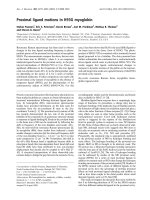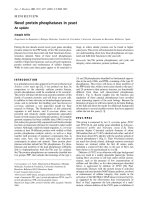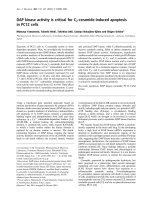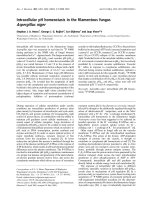Báo cáo y học: "Matrix Metalloproteinase Activity in Pediatric Acute Lung Injur"
Bạn đang xem bản rút gọn của tài liệu. Xem và tải ngay bản đầy đủ của tài liệu tại đây (836.44 KB, 9 trang )
Int. J. Med. Sci. 2009, 6
9
I
I
n
n
t
t
e
e
r
r
n
n
a
a
t
t
i
i
o
o
n
n
a
a
l
l
J
J
o
o
u
u
r
r
n
n
a
a
l
l
o
o
f
f
M
M
e
e
d
d
i
i
c
c
a
a
l
l
S
S
c
c
i
i
e
e
n
n
c
c
e
e
s
s
2009; 6(1):9-17
© Ivyspring International Publisher. All rights reserved
Research Paper
Matrix Metalloproteinase Activity in Pediatric Acute Lung Injury
Michele YF Kong
1
, Amit Gaggar
2,3
, Yao Li
1
, Margaret Winkler
1
, J Edwin Blalock
3
, and JP Clancy
1
1. Departments of Pediatrics, University of Alabama at Birmingham, Birmingham, AL, 35233, USA
2. Departments of Medicine, University of Alabama at Birmingham, Birmingham, AL, 35233, USA
3. Departments of Physiology and Biophysics, University of Alabama at Birmingham, Birmingham, AL, 35233, USA
Correspondence to: Michele YF Kong, MD, Suite 504, 1600 7
th
Avenue South, Birmingham AL 35233. Phone: 205-939-9387;
Fax: 205-975 6505; Email:
Received: 2008.09.11; Accepted: 2008.12.15; Published: 2008.12.16
Abstract
Pediatric Acute Lung Injury (ALI) is associated with a high mortality and morbidity, and
dysregulation of matrix metalloproteinases (MMPs) may play an important role in the
pathogenesis and evolution of ALI. Here we examined MMP expression and activity in pedi-
atric ALI compared with controls. MMP-8, -9, and to a lesser extent, MMP-2, -3, -11 and -12
were identified at higher levels in lung secretions of pediatric ALI patients compared with
controls. Tissue Inhibitor of Matrix metalloproteinase-1 (TIMP-1), a natural inhibitor of
MMPs was detected in most ALI samples, but MMP-9:TIMP-1 ratios were high relative to
controls. In subjects who remained intubated for ≥10 days, MMP-9 activity decreased, with >
80% found in the latent form. In contrast, almost all MMP-8 detected at later disease course
was constitutively active. Discriminating MMP-9:TIMP-1 ratios were found in those who had
a prolonged ALI course. These results identify a specific repertoire of MMP isoforms in the
lung secretions of pediatric ALI patients, and demonstrate inverse changes in MMPs -8 and -9
with protracted disease.
Key words: matrix metalloproteinases, acute lung injury, pediatric, viral infection
INTRODUCTION
Matrix metalloproteinases (MMPs) are involved
in many normal homeostatic mechanisms. However,
accumulating data suggests that MMP dysregulation
can contribute to the pathology of chronic lung dis-
orders, such as asthma (1-2), emphysema (3), chronic
obstructive pulmonary disease (4), bronchopulmon-
ary dysplasia (5-6) and cystic fibrosis (CF) (7-8). High
levels of MMP-2, -8, and -9 have also been demon-
strated in lung diseases with an acute onset, such as
adult ALI and Acute Respiratory Distress Syndrome
(ARDS) (9-12) and Respiratory Distress Syndrome
(RDS) of the newborn (5). MMP isoform expression
and activity in pediatric ALI, however, remains
largely unknown. Unique aspects of MMP expression
and activity might be predicted in this population
relative to others, since the causes of pediatric ALI
differ from those of acute respiratory failure in other
age groups, with a strikingly higher incidence of viral
lower respiratory tract disease leading to ALI in chil-
dren compared to adults (13-14).
Here we report MMP expression and activity
profiles in pediatric ALI subjects compared with well
pediatric controls, including examination of TIMP
expression. We hypothesized that a unique MMP
profile exists in lung secretions of pediatric ALI sub-
jects, and that dysregulated MMP activity may play a
role in the pathogenesis and evolution of this disease.
We identified increased MMP-8 and -9 activities in
pediatric ALI with corresponding expression of
TIMP-1. In those with persistent disease, MMP-9 ac-
tivity dropped later in the disease course relative to
MMP-8 activity, which remained elevated. Our find-
ings highlight important changes in MMP isoform
expression and activity with disease state, and may
Int. J. Med. Sci. 2009, 6
10
identify novel disease biomarkers and potential tar-
gets for intervention.
MATERIALS AND METHODS
ALI subjects
Lung secretions were collected via endotracheal
suctioning from intubated pediatric patients with a
known diagnosis of ALI within 24 hours of intuba-
tion, with serial samples collected approximately
every 12 hours for the duration of intubation. Samples
were collected with a suction cannula (8F-12F, de-
pending on endotracheal tube size) inserted past the
end of the endotracheal tube. All subjects were en-
rolled consecutively over a 1 year period. Approval
from the Institutional Review Board at The University
of Alabama at Birmingham and informed consent was
obtained prior to sample collection. Exclusion criteria
for the study included immunosuppresion (recent
steroids or cytotoxic therapy), transplantation or fail-
ure to obtain study consent.
Definition of Acute Lung Injury
ALI was defined as hypoxemia (ALI PaO2/FiO2
≤ 300 mm Hg, ARDS PaO2/FiO1 ≤ 200), bilateral in-
filtrates on frontal chest radiograph, pulmonary ar-
tery occlusion pressure ≤ 18 mm Hg when measured,
or no clinical evidence of left atrial hypertension (15).
Virus-induced ALI was defined as ALI caused by any
viral etiology as determined by a positive rapid viral
screen (direct fluorescent antibody for RSV, adenovi-
rus, influenza A or B or parainfluenza virus) or viral
culture.
Control subjects
Control subjects were pediatric patients with no
known lung disease undergoing elective surgical
procedures in the Operating Room (OR). All subjects
screened for chronic lung disease prior to surgery
were excluded from the study. Samples were obtained
during the standard care of the endotracheal tube,
which was typically performed in the earlier portions
of the procedures. No patient identifiers were col-
lected with these samples. Predominant diagnoses
within the controls included elective tonsillectomies
and/or adenoidectomies, with a median age of 4
years. 14 subjects were enrolled over a 3 month pe-
riod.
Endotracheal aspirate processing
Once collected, endotracheal tube aspirates were
centrifuged at 1000 RPM at 4°C for 10 minutes. The
supernatant was collected, protein concentration was
measured as described by the manufacturer (Bio-Rad,
Catalog # 5000112), and separate aliquots were saved
at 4° C for immunoblotting and quantitative analysis
as outlined below.
Detection of MMP and TIMP isoforms by
Western Blot analysis
All patient samples were electrophoresed on
SDS-polyacrylamide gels (20 µg protein/ sample was
loaded for each immunoblot lane) according to a
modified method by Laemmli (16) and electroblotted
onto Immobilon-P PVDF membranes. Membranes
were blocked in Tris buffer (pH=7.4) containing 5%
powdered milk for one hour, washed and incubated
with primary antibody of interest overnight at 4°C.
After incubation, samples were washed with borate
saline (100 mM boric acid, 25 mM Na borate, 75 mM
NaCl) and incubated with species-specific IgG horse-
radish peroxidase conjugates (at dilutions of 1:5000)
for one hour. Immunoblots were then developed us-
ing ECL chemiluminescent kits (GE Healthcare, Pis-
cataway, NJ).
Zymography
To measure total gelatinase activity, zymogra-
phy was performed on all patient samples using a
modification of a technique previously described (17).
In brief, samples (10 ug protein/sample) were sub-
jected to electrophoresis through 7.5% polyacrylamide
gels containing 1 mg/ml porcine skin gelatin in the
presence of SDS under non-reducing conditions. Fol-
lowing electrophoresis, gels were washed in 2.5%
Triton X-100 for 1 hour at 4°C, then incubated in 50
mM TRIS, 5 mM CaCl
2
for 16 hours at 37°C. Gels were
stained for 30 minutes in Coomassie blue and de-
stained for 1-2 hours.
Measurement of MMP-8, MMP-9, and TIMP-1
activity
MMP-8, -9 and TIMP-1 activity were quantified
using ELISA-based activity assays (F8M00, F9M00,
DTM100; R and D systems, Minneapolis, MN). The
manufacturer’s sensitivity (minimum detectable con-
centration) for individual kits was 0.021 ng/ml for
MMP-8, 0.005 ng/ml for MMP-9 and 0.08 ng/ml for
TIMP-1. Briefly, samples and recombinant enzyme
standards were incubated for two hours at room
temperature in 96-well plates coated with monoclonal
antibodies for MMP(s) (MAB 908 for MMP-8 and
MAB 911 for MMP-9) of interest, followed by activa-
tion with 1 mM aminophenylmercuric acetate
(APMA), a chemical activator of MMPs. After incuba-
tion for another two hours at 37°C, a fluorogenic sub-
strate (Fluor-Pro-Leu-Gly-Leu-Ala-Arg-NH2) was
placed in each well and the plate was incubated at
37°C for 18 hours. The plate was then read on a spec-
trophotometer (SpectraMax Gemini, Molecular De-
Int. J. Med. Sci. 2009, 6
11
vices, Sunnyvale, CA; excitation and emission wave-
length of 320 and 405, respectively) and data was
quantified using standard curves provided with the
kits. For the studies of TIMP-1, samples and recom-
binant TIMP-1 standards were incubated for two
hours at room temperature in 96-well plates coated
with TIMP-1 monoclonal antibodies. Bound TIMP-1
was then conjugated with a horseradish peroxi-
dase-based secondary antibody for one hour. A col-
orimetric substrate (hydrogen peroxide and chroma-
gen) was placed in each well and color change was
quantified on a colorimeter (Bio-Rad, Hercules, CA)
within 30 minutes via standard curves provided with
the kits.
Reagents
The following primary monoclonal antibodies
were used to immunoblot for the various MMPs and
TIMPs of interest. MMP-8 (MAB 3316; Chemicon),
MMP-9 (MAB 911; R/D Systems), MMP-2 (MAB 9022;
R/D Systems), MMP-3 (MAB 905; R/D Systems),
MMP-11 (MAB 3365; Chemicon), MMP-12 (MAB 919;
R/D Systems), MMP-1 (MAB 901; R/D Systems),
MMP-7 (MAB 9071; R/D Systems), MMP-10 (MAB
910; R/D Systems), MMP-19 (RP3MMP19; Triple
Point Biologics, Inc, Forest Grove, OR), MMP-26
(RP2MMP26; Triple Point Biologics, Inc), MMP-27
(RP2MMP27; Triple Point Biologics, Inc), TIMP-1
(MAB 970; R/D Systems) and TIMP-2 (MAB 971; R/D
Systems). All recombinant MMPs and TIMPs were
purchased through either R and D Systems (Minnea-
polis, MN) or Chemicon (Temacula, CA).
Statistics
Descriptive statistics including mean and stan-
dard error of the mean (SEM) were determined for all
continuous data. ANOVA, paired and unpaired t-tests
were used for comparisons of MMP and TIMP activi-
ties utilizing Sigmastat statistical software (Jandel,
CA). A p-value < 0.05 was used to determine statisti-
cal significance. As this was an exploratory study to
examine MMP expression and activity in the study
group relative to controls, no formal power calcula-
tions were performed in advance of sample collection.
RESULTS
Expression of MMP and TIMP Isoforms in Pe-
diatric ALI
Table 1 provides a summary of demographic
and diagnostic information regarding the pediatric
ALI subjects. The diagnoses and ages of ALI subjects
were typical for those normally cared for in this terti-
ary PICU. 68% of patients enrolled met criteria for
ARDS, the most severe form of ALI. Global mortality
was 16% while 44% of subjects had multi organ fail-
ure.
Table 1: Demographic and diagnostic information of study
subjects
ALI (all) †Prolonged
ALI
Number 25 12
ARDS 17 9
Admission
PaO2/FiO2
(Mean ± SEM)
159 ± 13
143 ± 17
Admission OI index
(Mean ± SEM)
24 ± 3 29 ± 5
Age:
Median (Range)
6 yr
(1mo - 18yr)
4.6 yr
(1mo - 13yr)
Gender
M/F
15/10 7/5
Pneumonia (8) Pneumonia (4)
Sepsis (6) Sepsis (3)
Asthma (4) Aspiration (2)
Bronchiolitis (2) Asthma (2)
Aspiration (2) Trauma (1)
Acute chest syndrome (1)
Pulmonary hemorrhage (1)
Diagnosis
Trauma (1)
Steroids 4 2
Multi Organ Failure 11 6
Death 4 2
†Prolonged ALI: ALI and ventilator days ≥ 10.
Figure 1 provides a plot of the number of ALI
subjects and their duration of intubation. Based on the
inherently bimodal distribution of the data (for the
purposes of our analysis), and the lack of consensus
regarding definitions of early or late ALI (11, 18),
subjects who were extubated before day 10 (N=13)
were defined as ‘short course’ ALI, while those who
were not were defined as ‘prolonged ALI’ (meeting
ALI criteria and requiring intubation ≥10 days, N=12
subjects). The average number of intubated days for
this group of patient was 17 versus 4 days in those
with a ‘short course’ ALI (p < 0.0009). Thus, this
natural breakpoint defined two patient groups with
vastly different needs for ventilatory support. To de-
fine the MMP profile of all ALI subjects, lung secre-
tions collected from days 0 to 10 of intubation for each
subject were pooled and probed for MMP isoform
expression by zymography and western blotting.
Samples were pooled due to occasional inadequate
sample volumes that limited longitudinal analysis. An
example of gelatinase activity found in lung samples
from one subject over time is shown in Figure 2A,
demonstrating a rapid increase and progression over
days 0-4 of disease. MMP-8 and MMP-9 were identi-
fied in the majority of ALI samples (Figures 2B and
2C), with lower levels of MMP-2, -3, -11 and -12 de-
Int. J. Med. Sci. 2009, 6
12
tected in some ALI samples (data not shown). Other
MMPs screened but not detected included MMPs
-1,-7,-10,-19,-26 and -27. Lung secretions were also
probed for expression of natural MMP inhibitors
TIMP-1, and -2. Only TIMP-1 was detected in the
majority of ALI samples, while antibodies to TIMP-2
failed to identify this inhibitor in screened samples.
Figure 1: Number of ventilator days for each ALI subject
(N=25). 12 ALI patients went on to have a protracted
course, requiring ventilatory support for ≥ 10 days. The
mean number of intubated days for this subgroup was
17±3.3 days, compared to 4±0.6 days for the rest of the ALI
subjects (Mean±SEM; p< 0.0009).
MMP-8 and MMP-9 Activity in Pediatric ALI
Based on the results of our screening summa-
rized in Figure 2, we examined the activities of
MMP-8 and MMP-9 in all ALI subjects (N=25, days
0-10) compared to controls. Active MMP-8 was
up-regulated in ALI subjects, with an approximately
7-fold increase compared to controls (Figure 3A, p <
0.004). Total MMP-8 activity, determined post APMA
stimulation of latent MMP-8 was elevated approxi-
mately 3.5-fold (Figure 3B, p < 0.04). Figure 4 sum-
marizes mean active and total (including detection of
latent MMP-9 by APMA stimulation) MMP-9 activity
in ALI samples, demonstrating that both active and
total MMP-9 activity was up-regulated (approxi-
mately 3-fold higher when compared with control
values, p < 0.0003). Because viral respiratory infec-
tions are a common cause of bronchiolitis and pneu-
monia that lead to ALI in the pediatric population, we
examined MMP-8 and MMP-9 activities in vi-
rus-induced ALI compared with non-viral ALI. We
found insignificant elevations in total MMP-8 and 9
activities in subjects with viral ALI (RSV=4, Parain-
fluenza=2) compared to non-viral ALI subjects (viral
ALI MMP-8=49±22 ng/mg, non-viral ALI MMP-8=24
±9 ng/mg; p≈ 0.3; viral ALI MMP-9=582 ± 300 ng/mg,
non-viral ALI MMP-9=402±57 ng/mg; p≈ 0.4).
Figure 2: Expression of MMP-8 and MMP-9 in pediatric
ALI. For 2B-2C, each lane represents lower airway secre-
tions from a separate ALI subject. ‘+’ represents recom-
binant MMP of interest as positive control. 2A. Zymogram
(7.5% SDS non-reduced gel) demonstrates increasing ge-
latinase activity in lung samples from one ALI subject over
time. Each lane represents a sample obtained every 12 hrs
from time of intubation to Day 4. 2B. Western blot (7.5%
SDS reduced gel) demonstrates prominent MMP-8 staining
(70 kDa, black arrow) in ALI samples. The faint higher
molecular weight bands at ~85kDa (grey arrow) likely
represent pro-MMP-8 isoforms. 2C. Western blot (7.5%
SDS non-reduced gel) shows prominent MMP-9 staining (78
kDa, black arrow) in ALI samples. The higher molecular
weight band at 135 kDa (grey arrow) is consistent with
lipocalin:MMP-9 complexes.
TIMP-1 and MMP-9:TIMP-1 Activity in Pediat-
ric ALI
Since TIMP-1 normally provides negative regu-
lation to MMP-9 in tissue compartments, we exam-
ined TIMP-1 activity and MMP-9:TIMP-1 activity ra-
tios in our ALI samples (all subjects, N=25, days 0-10)
compared with controls. Although TIMP-1 was de-
tectable in the lung secretions of most ALI subjects,
there was no significant difference in activity between
ALI and control subjects (ALI=137±19 ng/mg, con-
trol=109±13 ng/mg; p≈ 0.4), leading to a higher MMP-
9:TIMP-1 activity ratios in the ALI samples compared
to controls (Figure 5, p < 0.006). We then examined
Int. J. Med. Sci. 2009, 6
13
these parameters in subjects who went on to have a
prolonged course of ALI (ventilatory support for ≥10
days, N=12). MMP-9 and MMP-9:TIMP-1 activity ra-
tios in ‘short course’ ALI (N=13 subjects, samples
from days 0-10) were higher than those in compli-
mentary samples from the ‘prolonged ALI’ subjects
(N=12 subjects, samples from days 0-10) (Table 2).
Thus, high MMP-9:TIMP-1 activity ratios during days
0-10 correlated with subjects who exhibited more
rapid disease resolution within our study population.
Table 2: MMP-9 activity, TIMP-1 activity, and
MMP-9:TIMP-1 activity ratios (days 0-10) of short course
ALI compared with prolonged ALI
Short course ALI
(N=13)
Prolonged ALI
(N=12)
MMP-9 activity
(±SEM)
599±129 ng/mg 372±112 ng/mg
TIMP-1 activity
(±SEM)
127±34 ng/mg 155±21 ng/mg
MMP-9:TIMP-1
activity ratio
(±SEM)
12±4* 2.7±0.9
*p< 0.03
Figure 3: Mean (±SEM) MMP-8 activity in ALI subjects
(N=25) relative to controls (N=14). Total MMP-8 level was
measured following chemical stimulation of samples with
APMA (1 mM) to activate latent MMP-8. 3A. Active MMP-8
is up-regulated in lung secretions of ALI subjects compared
to controls (ALI=33±8.9 ng/mg, control=4.7±1 ng/mg; * p <
0.004). 3B. Total MMP-8 activity is higher in lung secretions
of ALI subjects compared to controls (ALI=61±20 ng/mg,
control=17±3 ng/mg; * p < 0.04).
Figure 4: Mean (±SEM) MMP-9 activity in ALI subjects
relative to controls. Total MMP-9 level was measured fol-
lowing chemical stimulation of samples with APMA (1 mM)
to activate latent MMP-9. 4A. Active MMP-9 is up-regulated
in ALI lung secretions compared to controls (ALI= 490±85
ng/mg, control=147± 39 ng/mg; * p < 0.0005). 4B. Total
MMP-9 is up-regulated in ALI lung secretions compared to
controls (ALI= 668±88 ng/mg, control=230± 63 ng/mg; * p
< 0.0003).
Figure 5: Mean MMP-9:TIMP-1 activity ratio in ALI subjects
was approximately 8-fold higher when compared to con-
trols (* p < 0.006).









